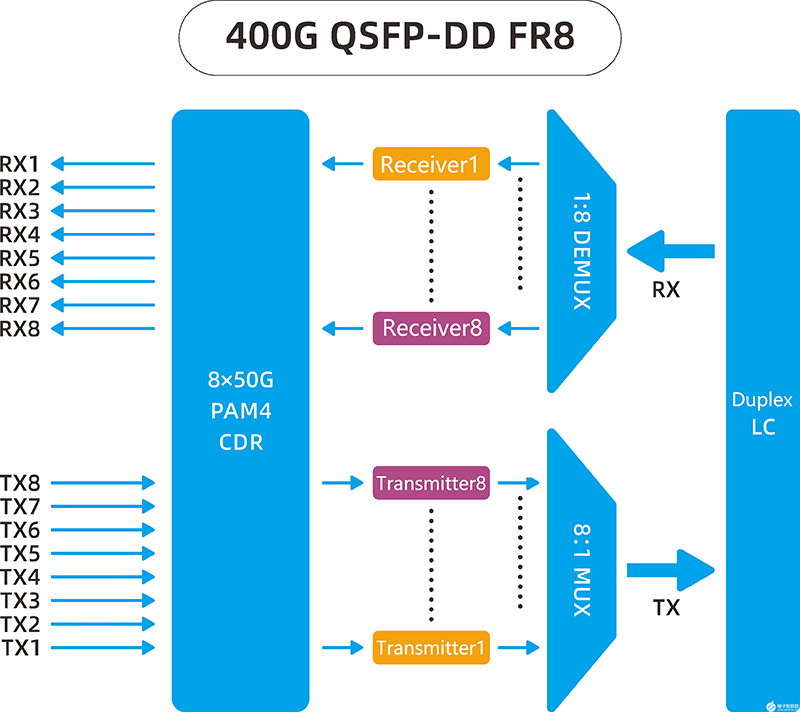

 Knowledge Base +
Knowledge Base +  2024.01.10
2024.01.10As the technology continues to upgrade and evolve, cost and performance will drive the 400G optical communication market, causing the number of 400G data centers to climb. In 400G data centers, two types of optical modules are available for 2km WDM solution, 400G QSFP-DD FR4 and 400G QSFP-DD FR8.
Reliability
The 400G QSFP-DD FR4 has a baud rate of 53.125 GBd and the 400G QSFP-DD FR8 has a baud rate of 26.5625 GBd. As the baud rate increases, the MPI cost and CD cost of the PAM4 increases, and it faces the challenge of reliable operation over time, which calls for the adoption of a more robust FEC and the resolution of interoperability issues. Both optical modules adopt KP4 FEC, 400G QSFP-DD FR4 with >80% margin per channel and 400G QSFP-DD FR8 with >90% margin per channel, 400G QSFP-DD FR8 is more reliable compared to others.
Modulation Method
Both 400G QSFP-DD FR4 and 400G QSFP-DD FR8 have 8-channel 53Gbps PAM4 modulation on the electrical side, but the difference is on the optical side, which uses 8-channel 53Gbps PAM4 modulation on the optical side of FR8 and 4-channel 106Gbps PAM4 modulation on the optical side of FR4, and internally, the Gearbox chip is used to multiplex the inputs of the two electrical ports into a signal and then modulate the signal to the optical side. The Gearbox chip is used internally to multiplex the two electrical inputs into one signal and then modulate the signal to optical, so the rate on the optical side is twice the rate on the electrical side, i.e., four 106Gbps PAM4 signals. 50G PAM4 is upgraded to 100G PAM4 modulation, and the dispersion tolerance is reduced.


DSP Delay
Due to the internal use of an 8:4 Gearbox in the 400G QSFP-DD FR4, this results in poorer latency performance of ~102ns, while the 400G QSFP-DD FR8 has only ~84ns latency. Therefore, 400G QSFP-DD FR8 has better latency performance. For selection, 400G QSFP-DD FR8 is more suitable for scenarios that require high-performance computing.
*Latency data from Broadcom DSP specification for reference.
Power Consumption
The 400G QSFP-DD FR8 offers improved link budgets on the one hand, but on the other hand, the use of more lasers makes the modules more power hungry, the total laser cost per module is higher, and the optical packaging is more complex, resulting in lower yields and higher production costs. In contrast 400G QSFP-DD FR4 has lower power consumption and simpler heat treatment capabilities.
| program | 400GQSFP-DDFR42km | 400GQSFP-DDFR82km |
|---|---|---|
| baud-rate | 53.125GBd | 26.5625GBd |
| DSP delay | ≈102ns | ≈84ns |
| MPI cost | weak | passable |
| CD cost | weak | passable |
| KP4FECMargin | reliably | very reliable |
| power wastage | few | large |
| Transmission Performance | general | preferably |
In summary, the 8-way optical 400G QSFP-DD FR8 offers better transmission performance in all aspects compared to the 400G QSFP-DD FR4, but is slightly less powerful and costly. 400G QSFP-DD FR4 is suitable for commercial data centers, and 400G QSFP-DD FR8 is more suitable for high-performance computing.
Walsun is an advocate of 8-way optics, with an original 8-way optical engine design that dramatically improves producibility and reliability.
What are the uses of the QSFP DD 400G LR4 optical transceiver
Is QSFP compatible with QSFP DD
Is QSFP28 compatible with QSFP DD
400GBASE QSFP DD LR4 Whats Inside
Subscribe to the newsletter
for all the latest updates.
2-5# Building, Tongfuyu Industrial Zone, Aiqun Road, Shiyan Street, Baoan District, Shenzhen. China
